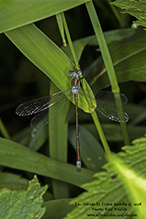spotted spreadwing
(Lestes congener)
Conservation • Description • Habitat • Ecology • Distribution • Taxonomy
|
|
||||||||||||||
Description |
Spotted Spreadwing is a common, small, late-flying damselfly. It occurs across the United States and southern Canada except in the southeast. It is absent from the southeastern states from North Carolina to Florida west to Kansas and Texas. It is found from mid-July to late October at the edges of lakes and ponds, by slow streams, and in seasonal and permanent wetlands. Adults are 1¼″ to 1⅝″ (32 to 42 mm) long and stocky. The upperside of the thorax of the male is black with bronze iridescence, a thin pale stripe in the center (dorsal stripe), and a thin pale shoulder stripe on each side. The sides of the thorax are pale whitish-gray. On each side there is a pair of prominent dark spots on the lower thorax that gives this damselfly its common name. The abdomen is slender, black with bronze iridescence above, brown or pale below. The last two abdominal segments have a conspicuous, gray, powdery coating (pruinescence). The wings are clear except for a single dark cell (stigma) near the tip. The legs are long and slender. The head is black and the compound eyes are blue. As the male ages it develops a white powdery coating on the thorax, on the first two abdominal segments, and on the sides and underside of abdominal segments 6 through 8. On the female the head and eyes are brown, the upper side of the thorax is dark brown, and the abdomen is thicker. The ovipositor is short and does not extend beyond the tip of the abdomen. |
Size |
Total length: 1¼″ to 1⅝″ (32 to 42 mm) |
Similar Species |
Habitat |
Edges of ponds and lakes, wetlands |
Ecology |
Season |
Mid-July to late October |
Behavior |
The wings are held spread at about a 45° angle when at rest. |
Life Cycle |
Eggs are laid above water in the dried stems of bulrushes. Eggs overwinter and hatch in late spring. |
Naiad Food |
|
Adult Food |
|
Distribution |
||
|
Sources |
|
| 4/21/2025 | ||
Occurrence |
||
Common |
||
Taxonomy |
|
Order |
Odonata (Dragonflies and Damselflies) |
Suborder |
|
Superfamily |
Lestoidea |
Family |
Lestidae (spreadwings and allies) |
Genus |
Lestes (pond spreadwings) |
Subordinate Taxa |
|
|
|
Synonyms |
|
|
|
Common Names |
|
spotted spreadwing |
|
Glossary
Pruinescence
A waxy or powdery bloom that covers the underlying coloration and gives a dusty or frosty appearance.
Stigma
In plants, the portion of the female part of the flower that is receptive to pollen. In Lepidoptera, an area of specialized scent scales on the forewing of some skippers, hairstreaks, and moths. In other insects, a thickened, dark, or opaque cell on the leading edge of the wing.
Visitor Photos |
||
Share your photo of this insect. |
||
This button not working for you? |
||
Alfredo Colon |
||
 |
||
 |
 |
|
 |
 |
|
 |
 |
|
 |
 |
|
 |
 |
|
 |
 |
|
Scott Bemman |
 |
MinnesotaSeasons.com Photos |
||
|
||
|

Slideshows |
|

Visitor Videos |
||
Share your video of this insect. |
||
This button not working for you? |
||
|
Other Videos |
||
Lestes congener, male (Dragonfly) Wetlands Park-LV-NV-USA 10 8 2018 Antonio Silveira |
About
Aug 12, 2018 Dragonflies of Nevada-USA by Antonio Silveira |
Slender Spreadwing (Lestidae: Lestes rectangularis) Mating |
About
Aug 12, 2010 Photographed at the Turtle River State Park, North Dakota (11 August 2010). |

Visitor Sightings |
||
Report a sighting of this insect. |
||
This button not working for you? |
||
| Alfredo Colon 8/26/2022 |
Location: Albany, NY |
 |
| Alfredo Colon 8/25/2022 |
Location: Albany, NY |
 |
| Alfredo Colon 8/18/2022 |
Location: Albany, NY |
 |
| Alfredo Colon 8/17/2022 |
Location: Albany, NY |
 |
| Alfredo Colon 8/15/2022 |
Location: Albany, NY |
 |
Alfredo Colon |
Location: Albany, NY |
 |
| Scott Bemman Summer 2020 |
Location: Hayes Lake State Park |
 |
| Alfredo Colon Summer 2018 |
Location: Woodbury, MN |
 |
MinnesotaSeasons.com Sightings |
||
|

Created: 1/15/2020 Last Updated: © MinnesotaSeasons.com. All rights reserved. |
